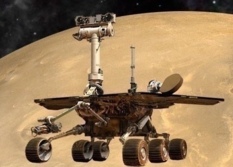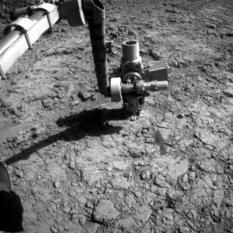A.J.S. Rayl • Jan 08, 2016
Mars Exploration Rovers Update: Opportunity Finishes Another Record Year, Approaches 12th Anniversary
Sols 4214–4244
Perched on the southern wall of Marathon Valley at Endeavour Crater, Opportunity braved temperatures descending well below -100° Fahrenheit [-73.33° Celsius] in December to work the winter science campaign and home in on the remnants of ancient clays. By month’s end, the Mars Exploration Rovers (MER) mission wrapped another productive Earth year of surface exploration and just around the corner was its 12th anniversary.
While the human members of the MER ops team tried to get a little rest or catch up on work during the holidays, the veteran robot field geologist focused on the sometimes-tedious detective work needed to zero in on the rocks and soils that are harboring the remnants of clay minerals that the MER team came to uncover.
Known as smectites, they were first detected from orbit. Since they form in neutral to high pH or alkaline water, they provide strong evidence that water much like we drink on Earth once flowed through or permeated this part of Mars, at a time billions of years ago planetary scientists generally believe when Mars had water and was more like Earth.
The MER scientists are confident that the residue of the smectites are in the rocks and soils that appear deep red, as opposed to the tan red rocks that make up most Martian landscapes. But they have not confirmed that yet and the rover has just started to do the investigative work.
The Martian winter officially begins in the southern hemisphere of the planet with solstice January 3, 2016. But temperatures have been dropping at Endeavour Crater for several months.
Opportunity was in good shape producing welcomed power levels, ranging from 387 to upwards of 440 watt-hours in December. “This past winter, Opportunity's power levels were higher than the last three winters,” said John Callas, MER project manager, of the Jet Propulsion Laboratory (JPL), home to all NASA’s Mars rovers.
Even so, Mars is farther from the Sun than Earth, and it has an atmosphere that is too thin to retain heat. “It’s so friggin’ cold,” said Ray Arvidson, MER deputy principal investigator of Washington University St. Louis. “The batteries just aren’t as efficient during winter, the shadows are pretty significant, and we have to spend more time recharging.”
From the sounds of it, Arvidson could have been talking about humans. But he was, of course, talking about the rover Opportunity. Despite the “friggin’ cold,” the rover, managed to brush and grind into two rock targets, as well as take dozens of images and forge on into winter, “moving, working, and testing the hypothesis that the red zone rocks are carrying the smectite signature detected by CRISM,” he said.
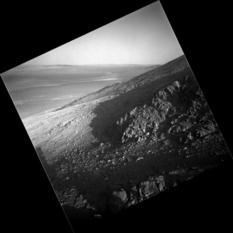
A parting view
Opportunity took this parting view of 2015 on Mars with her Navigation Camera (Navcam) in late December from her location on the southern wall of Marathon Valley at Endeavour Crater. From the raw image, Stuart Atkinson, planetary author, speaker, and MER poet, produced the view above. For more of Atkinson's work, see: The Road to Endeavour.NASA / JPL-Caltech / S. Atkinson
CRISM is the Compact Reconnaissance Imaging Spectrometer for Mars, which is onboard the Mars Reconnaissance Orbiter (MRO). It searches the surface of Mars for the “signatures’ of minerals that form in the presence of water, from hot springs to thermal vents to lakes or ponds, past or present. In 2009, as Opportunity was on her way from Victoria Crater to Endeavour, CRISM detected a mother lode of phyllosilicates, in the forms of various kinds of smectites, in Marathon Valley.
Opportunity finally drove into the valley in mid-July this past year and began a walkabout or geological survey of the area. The smectites were elusive and the mission had to persevere technical issues ranging from missed communications with the Deep Space Network (DSN) to problems traced to the rover’s errant flash or long-term memory.
The rover’s flash had degraded significantly in 2014, causing Opportunity to have an increasing number of "amnesia" events, where flash failed to start or where the robot was unable to save her data in the memory drive before going to sleep. Either way, when she woke up, there was no data; hence the descriptor, ‘amnesia.’ The veteran rover was also experiencing sudden reboots.
The MER software engineers traced the issues to one of the eight banks in the non-volatile memory drive. In September and December 2014, they successfully reformatted flash. Neither effort stopped the issues.
As a result, Opportunity began 2015 using her back-up, Random Access Memory to store her daily data. RAM is volatile memory and only retains data while the robot is awake; therefore, the rover must uplink all data to one of the Mars orbiters the same Martian day on which she collects it before she goes to sleep.
New flight software enabled Opportunity to successfully mask off the corrupted bank in March 2015. But the bouts of amnesia and unexpected reboots returned every time the robot turned on flash. So she ended the year as she began it, operating in RAM mode.
Not surprisingly, the team known for its stellar workarounds had adapted well. Opportunity’s continued exploration in persistent RAM mode had “little impact” on mission operations, assessed Bill Nelson, chief of MER engineering at JPL. “We're really pleased with the way the rover is handling.”
As the Sun set on Mars and 2015, Opportunity and the MER mission completed another history-making year. The veteran robot field geologist achieved new rover engineering records despite her age, broken shoulder, arthritic front wheel, and troubled long-term memory, in large part because of a dedicated team of engineers.
At the same time, the scientists were transforming the research data Opportunity was collecting on the Martian surface into solar-system-class science, just as thrilled, humble, and grateful as ever to finish another year of roving, still adding clues to the mystery of the water a long, long time ago in our galaxy, far, far away – on Mars.
Pioneer that she is, Opportunity had quite a year in 2015. The rover completed her 4,000th sol (or Martian day) of exploring...escaped the ever-dangling budgetary axe...continued measuring argon for the mission-long study on the Martian atmosphere...toured one of the strangest craters the mission has come across...drove into Marathon Valley...and sent more of Mars home in panoramic postcards of breathtaking landscapes that to look, somehow, familiar.
All those achievements aside, 2015 will probably be most remembered as the Year of the Marathon. Opportunity, at Endeavour Crater, Mars, finished the first marathon on another planet beyond Earth and made history. “A first time happens only once,” said Callas.
With the highs in 2015 came the lows, and Martian recognitions. In September, the team named a ridge in honor of Noel Hinners. A legendary leader in space exploration, Hinners was a geologist and soil chemist by education and training, who held various titles at NASA in the 1970s and ‘80s. One of the most appreciated leaders in America’s venture into space, he died of cancer September 5th in Littleton, CO. He was 78. "Noel was really one of the greats of our business," said Squyres.
NASA/JPL issued the announcement along with a new Pancam image that showed Opportunity’s view of the north wall of Marathon Valley, Hinner’s Ridge above it.
In December, the team christened the southern wall or ridge of Marathon Valley after Danish astrophysicist, Jens Martin Knudsen, a longtime adviser to NASA and the scientist behind the magnets on Pathfinder/Sojourner and the MERs, as well as other spacecraft. “Jens Martin Knudsen was a pioneer in putting magnets onto the rovers, a simple, yet elegant way to understand mineralogy for magnetic phases,” said Arvidson. “It is thus fitting that we name an important feature after him.”
Opportunity and Spirit each carry five magnets, one set on their Rock Abrasion Tools (RATs), one set mounted on their fronts reachable for analysis by the Mössbauer and APXS instruments, and one to study wind-carried magnetic dust on the top of their decks, in view of the Pancam. These magnets accumulate air-fall fines; therefore, they have been important for understanding the dust mineralogy in the rovers’ Martian worlds. “Amazing to me was the relatively high abundance of very fine-grained magnetite,” Arvidson said. “Not all of the dust is composed of highly altered material.”
Knudsen passed away in February 2005, about a year after Spirit and Opportunity landed. But his work lives on, magnetically attracting Martian minerals as Opportunity continues her expedition.
Perched on the southern slopes of Marathon Valley, Opportunity was faring well as team members bid farewell to 2015. “Thinking back on this past year, and as we begin our 13th year of continuous roving and imaging on Mars, I am constantly reminded about how fortunate we are to have a capable, mobile vehicle out there helping us to explore Mars remotely,” reflected Jim Bell, Pancam lead and President of The Planetary Society, of Arizona State University (ASU).
“By studying the clay-bearing materials in and near Marathon Valley, we are making stronger connections between the orbital remote sensing observations from MRO, Mars Odyssey, and Mars Express and the surface-based science measurements that Opportunity is making,” Bell elaborated. “We continue to sample the chemistry of new types of materials, continue to be surprised by the variations in both the composition and geology of Meridiani Planum, and continue to be delighted by the stark beauty of the landscapes which we are vicariously experiencing through robotic eyes like Pancam's.”
“It was,” Arvidson summed up simply, “a good year.”
The mission’s 12th anniversary and the rover’s 12th birthday were just around the corner in January 2016, and the veteran rover rolled easily into the New Year.
“With each anniversary, we are reminded of what we have done and are doing – sustained exploration of the surface of Mars,” Callas offered. “We are continuing this new and exciting era of exploration of Mars.”
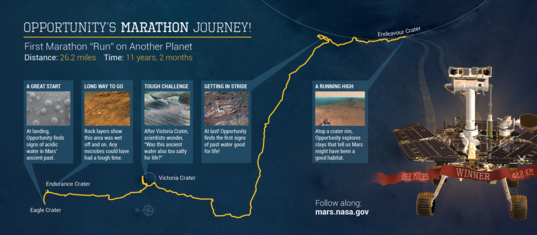
NASA / JPL-Caltech / Cornell / USGS / Arizona State University
2015: A marathon year
For all that Opportunity and the MER mission achieved in 2015, not the least of which was driving into Marathon Valley, the future will likely remember it as the Year of the Marathon. This graphic depicts a few of the highlights along the trails Opportunity has blazed since landing in January 2004. The rover surpassed a marathon distance of 42.195 kilometers (26.219 miles) – the first marathon ever completed on a planet beyond Earth – with a drive on her Sol 3968, Mar. 24, 2015, locking in another first for exploration history. "A first time only happens once," said MER Project Manager John Callas.2015 flashback...
Nearly 12 Earth years and 6 Mars years after Opportunity landed inside Eagle Crater, the operative word in 2015 seemed to be stamina.
When 2015 rang in on Mars, summer was about to begin shining on the southern hemisphere of the Red Planet. Opportunity was on the western rim of Endeavour Crater, about 100 meters from her next destination, the summit of Cape Tribulation.
The rover spent most of January roving, hiking to that summit, the highest peak she’s ever climbed, then getting back on the road south for Marathon Valley and the small, bizarre Spirit of St. Louis Crater at its entrance.
On January 24th, as the rover completed her 11th year of exploring the surface of the Red Planet, NASA-JPL released the panorama Opportunity took from Cape Tribulation. "It's satisfying to look back, but the most satisfying part of all to me right now is we're still looking forward," Steve Squyres, MER principal investigator of Cornell University, said then.
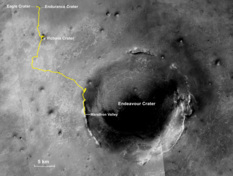
Opportunity's long and winding route
The gold line on this image, courtesy Larry Crumpler of the New Mexico Museum of Natural History and Science, shows Opportunity's route from her Eagle Crater landing site, upper left, to her location after her marathon drive in March 2015. The base image is a mosaic of images taken by the Context Camera onboard the Mars Reconnaissance Orbiter (MRO). "Hats off to an amazing engineering team," said MER Deputy Principal Investigator, Ray Arvidson.NASA / JPL-Caltech / MSSS / NMMNHS
Although it had been widely reported that Opportunity lost her memory because flash was turned at the end of 2014, the mission was actually managing quite well in RAM mode. The greatest threat to the rover actually was coming from Earth. Even though Opportunity had been granted a two-year extension in 2014, the NASA 2016 budget, prepared by the Office of Management and Budget (OMB), stated: "NASA plans to end Opportunity operations by FY 2016."
Undaunted, the MER team pressed onward. "We're basically pedal to the metal to try and get down to Marathon Valley," as Nelson put it then. By January’s end, the rover had left 380.03 meters (about 0.24 mile) in the Martian dust.
Staying the course southward along the western rim of Endeavour in February, Opportunity found a new rock type. “This is an outlier, something new, and different," said Squyres. The team named the mystery rock Jean Baptiste Charbonneau, after Sacagawea's son, the youngest member of the Corps of Discovery Expedition, more popularly known as the Lewis & Clark Expedition. And with Charbonneau, the team launched a new naming scheme they would use throughout the rest of the year.
"Charbonneau is a composition that's different than its surroundings, high in aluminum and silica and lower in magnesium and iron," said Arvidson. The rock could be either an igneous rock or impact melt that has undergone very little alteration. The scientists were “puzzling” over it.
Opportunity installed the updated, R9.4 flight software in February as planned, and the team set March 18, 2015 as reformat day. Important as flash has been to acquiring the lush images of Martian landscapes that have become hallmarks of this mission, the team demonstrated conclusively it could continue the expedition without it. "We discovered this new rock without flash and took an amazing panorama at Cape Tribulation,” Squyres said. “We can do it.”
Mars supportively whipped up a small gust or two that cleared some of the dust from the rover's solar arrays and gave Opportunity a bump in power. By month’s end, the rover was about 100 meters from Spirit of St. Louis Crater and the entrance to Marathon Valley, and 150 meters from completing the first marathon on another planet beyond Earth. Yet, along this section of the western rim of Endeavour Crater, rising above Marathon Valley, the rover found herself in a diversity of rocks that the scientists wanted to check out.

NASA / JPL-Caltech / Cornell / ASU
Cape Tribulation summit
Opportunity took this panorama from the top of Cape Tribulation in January 2015, about three weeks before her 11th anniversary. The rover climbed 135 meters (about 440 feet) in elevation from Botany Bay a lower section of Endeavour Crater's western rim traversed in mid-2013. This summit is the highest elevation the rover reached since departing Victoria Crater in 2008. Opportunity departed the Cape Tribulation summit on Jan. 17, 2015 (Sol 3902), and roved on toward Marathon Valley. The landscape is presented in false color to make differences in surface materials more easily visible.Since MER has always been a discovery driven mission, Opportunity took time during the early part of March to study a sampling of those rocks. The robot conducted in-depth investigations on two of them, Sgt. Charles Floyd and Sgt. Nathaniel Pryor, named after members of the Corps of Discovery. While Floyd appears blue in the false color Pancam images that the scientists use to better discern specific geological features and elements, Pryor, like Charbonneau, appears purple. However, if you were standing next to these rocks on Mars, they would not be blue or purple but a shade of dusty tannish red, because just about everything on Mars is red of one shade or another.
At the end of the Martian sol, Charbonneau, Floyd and Pryor turned out to be basalts. “It’s not like we found granite, but the diversity we’re seeing is important and a part of a bigger picture here,” said Arvidson. “We’re seeing signs of aqueous alteration and we’re also seeing that rocks tend to cluster in composition.”
Just like the team planned, Opportunity got her flash back in March. The robot lost 32 megabytes of storage space by masking off bank 7, but still had a total of 192 megabytes in six other banks to use. “The data that came back was perfect,” said Rebekah Sosland, then MER flight director and lead on the flash tiger team that was working the flash issue. But the amnesia and sudden reboot issues soon returned.
For MER’s software engineers, it was back to troubleshooting what they could. One complicating factor was that the company that made the flash drive no longer supports this version, having advanced pits memory drives some 10 or 15 generations beyond.
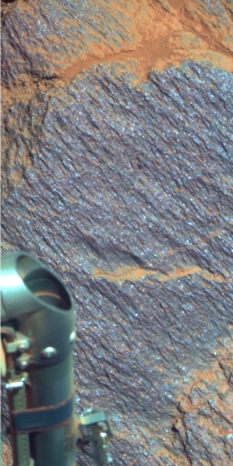
Studying Charbonneau
Opportunity spent much of the second week of February 2015 conducting an in-depth study of an intriguing outcrop called Jean Baptiste Charbonneau, after Sacagawea's son. "It is an outlier, something new, and different," said MER PI Steve Squyres. The robot took this image with her Pancam on Valentine's Day, and the Pancam team later processed it in false color, which gave it a purplish hue.NASA / JPL-Caltech / Cornell / ASU
Opportunity drove on and into the apron area surrounding Spirit of St. Louis Crater where intriguing patterns of light and dark markings in the flat, light-toned rocks caught the attention of the science team.
Meanwhile, on Earth, testimony from NASA Administrator Charles Bolden before the Senate Subcommittee on Space, Science and Competitiveness, March 12th, put MER’s potential budgetary plight back in the news. “We cannot continue to operate instruments and missions whose time has passed,” he said. “I have to make choices.”
In addition to have already been granted a two-year extension, Opportunity was sending home relevant and informative science. Fresh enough to complement and keep the MER mission in the science spotlights alongside the shinier Mars Science Laboratory / Curiosity, at the 46th annual Lunar and Planetary Science Conference (LPSC), held in Texas.
And, Opportunity is the only surface ‘bot investigating Noachian Period terrain, the time 3.7 to 4.2 billion years ago when Mars was more like Earth and may have featured environments conducive to the emergence of life.
If that wasn’t enough to justify her existence, during the overnight hours of March 23rd to March 24th for the rover ops team at JPL, the long awaited, much anticipated news arrived from Mars. The rover had woken up and taken off on a 46.9-meter (154-foot) dogleg jaunt around to the southwestern side of Spirit of St. Louis Crater – and made marathon history.
Consider that Opportunity’s original mission-success mobility objective was to drive 600 meters. So when the rover’s odometer turned past 42.195 kilometers (26.219 miles), MER raced back into the space history books. “This is the first time any human enterprise has exceeded the distance of a marathon on the surface of another world," announced Callas.
On Earth, members of the rover engineering team celebrated Opportunity’s magnificent March milestone with a MERathon, a marathon-length relay run at JPL on April 9th. More than 90 people took part, each running a 1.2-mile lap or more, up the hills and along the roads that wind through the Lab's grounds. Together, the runners would complete a marathon. Although Opportunity was working on Mars, her Earth-locked stand-in, Bubba, roved the last leg and “broke” the finish line ribbon.
Spirit and Opportunity set out in 2004 on the first overland expedition of Mars, a trek everyone hoped, all fingers crossed, would last 90 days. “It really has been a marathon,” Squyres said, thinking back on all the meters and miles driven since then. “And Opportunity’s marathon symbolizes this human team achievement.”
Given the history of the original marathon, the team named the rover’s targets around Spirit of St, Louis Crater after Greek places. The rover spent the rest of the March and much of April investigating the flat, light and dark toned outcrops in the southwestern part of the apron area, “visiting” Athens, Plataea, and Thessaloniki. The light-toned rocks at first looked a little like Whitewater Lake Formation – the oldest strata the rover uncovered on Matijevic Hill in the Cape York segment of Endeavour's western rim in 2012-2013. “But they’re not,” said Arvidson. Still, these outcrops weren’t like anything they’d seen before.

NASA / JPL-Caltech / Cornell University / Arizona State University
Marathon Valley overlook
This view from Opportunity shows part of Marathon Valley as seen from an overlook to the north. The landscape is presented in false color, a process that makes it easier to see differences in surface materials. Spanning east, left, to southeast, the scene combines images taken at four Pancam pointings in March 2015.While working away on the flat light-toned rocks, Opportunity crossed another kind of finish line as she completed her 4000th sol (or Martian day) of surface operations on April 26th. From the small crater’s apron, the rover drove 5 meters (about 15 feet) to just inside St. Louis Crater, onto “an outcrop peninsula,” as Mike Seibert, MER rover planner and lead flight director, described it.
There, the robot focused on a “purple” rock named Lambert Field, carrying out the routine MI pictures and APXS integrations. And NASA released the mission's latest big picture, a panorama of Spirit of St. Louis Crater.
Oddly oblong, fairly shallow, and unlike any crater the mission had encountered, it was named for the single engine, single seat, high-wing Ryan NYP monoplane (N-X-211) that Charles A. Lindbergh flew on his pioneering, solo Transatlantic flight from New York to Paris in May 1927.
A number of storms, including a regional guster in the northern hemisphere, whirled soil and stuff high into the skies and over parts of Mars’ southern hemisphere in April, and Martian dust rained down. But local winds around the western rim of Endeavour leveled the dusting field, clearing freshly deposited layers from Opportunity’s solar panels, and bumping up her energy.
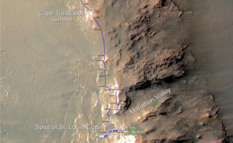
Marathon finish line
This map shows the southward path Opportunity took along the west rim of Endeavour Crater from late December 2014 until she passed marathon distance on March 24, 2015. On recent drives, the rover moved into the apron area surrounding Spirit of St. Louis Crater. In coming weeks, the rover will enter the small, oblong crater, study the unusual stack of rocks there, called Lindbergh Mound, and then drive into Marathon Valley.NASA / JPL-Caltech / UA
It helped make April another productive month, even though the robot suffered five more amnesia events and one sudden reboot. This time, the reboot featured “symptoms” different from any other the MER team had experienced with either Opportunity or Spirit, said Nelson.
“Every day is a concern," Squyres reminded. “We deal with it as it comes."
From Lambert Field, Opportunity drove around the outside of the small crater to its southern side to face Lindbergh Mound, the strange rockpile near its southern rim. Resembling a once carefully balanced stack of rocks that someone built on a beach, this kind of Martian cairn was and still is an enigma.
By Sol 4006 (May 1, 2015), the rover had started her tour inside Spirit of St. Louis Crater. She stopped at a number of science targets, including another blue rock, a vein, and a hummocky area, each named after person or place involved in Lindbergh’s astounding solo flight across the Atlantic in 1927.
All those decades before, Lindbergh climbed into his Spirit of St. Louis and rumbled down New York’s Roosevelt Field in the early morning hours of May 20, 1927...hit a storm over the Atlantic...and 33.5 hours later, landed at Le Bourget Airport in Paris. It was an almost unbelievable feat. It fired up the wanderlust for soaring through the skies and exploring the Earth. Lindbergh became an international hero overnight.
A number of uncanny parallels exist between Lindbergh and his Spirit of St. Louis and the MER team and its Spirit and Opportunity on Mars. For starters, both missions succeeded against all odds.
While Opportunity toured Spirit of St. Louis Crater, the MER scientists were debating how it came to be. Was the small, oblong crater a secondary impact, perhaps from what created Bopolu Crater far to the southwest of the rover, likely during the Hesperian Period or early Amazonian Period. Are the rocks in the crater and apron then simply pre-existing Shoemaker Formation rocks? “Not much ejecta is needed to make the crater and apron,” Arvidson pointed out.
Another possibility is that the crater is volcanic in origin and the mound is a ‘neck’ of frozen magma. Spirit of St. Louis remains a Martian mystery.
On Sol 4023 (May 19, 2015), Opportunity pulled out her RAT and brushed a spot one of the small ridges or knolls inside the small crater, what geologists call a hummocky area. It was named after Donald A. Hall, who with Lindbergh designed the legendary monoplane that now “flies” in the Smithsonian Air & Space Museum in Washington D.C.
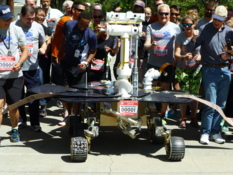
Breaking the tape
Bubba, one of the ground-based test MERs, "roved-in" for Opportunity and crossed the finish line last at the MERathon celebration marathon run at the Jet Propulsion laboratory. Participants in the first MERathon, the first Mars marathon on Earth for that matter, cheered Bubba on.Bill Nelson, JPL-Caltech
After clearing the surface of some dust, the robot followed the standard up-close investigation taking pictures with her Microscopic Imager (MI) and gleaning the chemical composition with her Alpha Particle X-ray Spectrometer (APXS). More than 11 years after landing and grinding into her first rock in Eagle Crater, Opportunity’s RAT was holding up remarkably well. “The RAT is still healthy and operating well,” reported Gale Paulsen, Senior Systems Engineer at Honeybee Robotics and Spacecraft Mechanism Corporation, the company that created the device. The RAT, he added, still had “approximately 25% of the bit life remaining and ready for future grinds.”
Opportunity also holding up remarkably well, producing power levels ranging from 508 to 536 watt-hours despite Beijing hazy skies that increased the atmospheric opacity or Tau to 1.333. The rover’s dust factor was better than good though, averaging 0.730. “There's absolutely nothing to complain about there,” Nelson summed up.
The veteran rover did suffer two amnesia events and two sudden reboots in May. “And there may have been additional, more subtle events,” said Nelson. Fortunately, no science was lost and the rover didn’t skip a beat. But the unexpected warm reboots ratcheted up concern and during the last week of the month, the team decided to take flash offline and return the rover to RAM mode.
Solar conjunction was fast upon them and while the team had hoped to spend it inside Marathon Valley, the plan changed. Opportunity would settle in where she was, at the northern edge of Spirit of St. Louis Crater.
A regular celestial event that happens once about every 26 months solar conjunction is when the orbits of Earth and Mars align the two planets on opposite sides of the Sun. This alignment disrupts radio transmissions between the two planets, so all Mars missions initiate what is effectively a communications blackout for two to three weeks. For the MER mission, the blackout this time around was slated from June 3rd-24th.
Opportunity hunkered down in good shape June 3rd. She was producing just under 500 watt-hours of energy, about half of her full power-producing capability on landing. Analyzing the chemical composition of two selected surface targets on Private William Bratton with her APXS and uplinking her data after every working sol to one of the NASA Mars obiters was easily doable for this rover. The MER scientists wanted to compare the Bratton findings with those from rocks the rover studied in the so-called red zones along the northern rim of Spirit of St. Louis Crater.
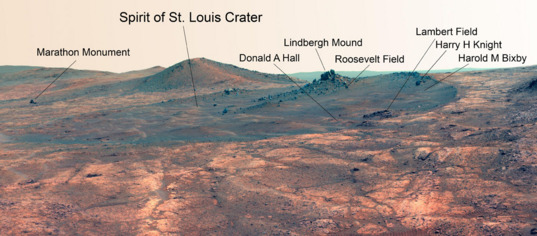
NASA / JPL-Caltech / Cornell / ASU
Spirit of St. Louis Crater
Names related to the first solo nonstop flight across the Atlantic have been informally assigned to a crater NASA's Opportunity Mars rover is studying. This false-color view of the Spirit of St. Louis Crater and the Lindbergh Mound inside it comes from Opportunity's panoramic camera.When the solar conjunction blackout was lifted June 24th, Opportunity phoned home, ready to rock and roll on. The team resumed normal tactical planning immediately and the following sol, the robot was dutifully carrying out her science in RAM mode.
When July dawned, fall was falling on Endeavour. Opportunity was still on the northern edge of Spirit of St. Louis Crater, hunkered down in a patch of deep red materials named Ryan NYP, conducting an in-depth investigation, just 55 meters (about 180 feet) from the entry point of Marathon Valley.
During the first two weeks of the month, the rover finished the assigned transect or comparative science campaign on targets in “red zones” along the northern rim of the small crater. With the exception of the dark rocks on Lindbergh Mound, the whole Spirit of St. Louis Crater area seems to have been “pretty well altered by fluids,” said Arvidson.
Then Destination Day arrived. On Sol 4079 (July 15, 2015), Opportunity took off on an 18.85-meter (61.84-foot) trek and drove into Marathon Valley.
From high overhead, the valley looks like a notch in Endeavour Crater's eroded western rim. It stretches west to east inside the 22-kilometer (13.67-mile) diameter crater, for some 330 meters (1082.67 feet). Down on the Martian ground, it looked like the home of the mother lode.
Ever since the CRISM screens ‘lit up’ with heavy concentrations of phyllosilicates in this area back in 2009, what subsequently came to be called Marathon Valley was a dream destination. Suddenly, the dream was alive.
Opportunity’s two mineral detectors – the Miniature Thermal Emission Spectrometer (Mini-TES) and the iron sniffing Mössbauer Spectrometer – are no longer detecting minerals. So, the scientists’ objective is to study the context for outcrops bearing clay minerals and neighboring deposits, just like they did at Matijevic Hill. That’s how the mission made history as the first to groundtruth phyllosilicates on Mars in 2013.
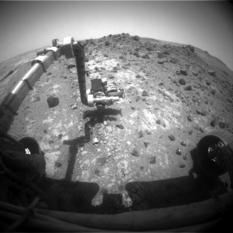
Examining Priv. William Bratton
Opportunity hunkered down for the Earth-Mars Solar conjunction command moratorium and communication blackout in one of the "red zones" that can be seen in different parts of the rim of Spirit of St. Louis Crater. The team named the area over which she perched after Private William Bratton, a member of the Corps of Discovery Expedition. During solar conjunction, the rover spent most of June gleaning the chemical composition of two targets amidst the broken-up rocks.NASA / JPL-Caltech
Inside Marathon Valley, the robot field geologist immediately began a "walkabout"—or scientific survey—as geologists of all makes are wont to do. Opportunity would take “a clockwise loop, heading eastward around the north wall, and then cross down to the south side and drive westward along the south wall," said Squyres. That’s where the solar-powered rover would spend her seventh Martian winter. She could position herself on north-facing slopes there, take in as much sunlight as possible, and probably produce plenty enough energy to rove and work throughout the harsh season.
Opportunity turned on her flash in the middle of the month for three sols, and it didn’t go well. “Unstable," said Callas. "The reality is that this flight software is old. It’s quite possible that there are several things going on,” he said. The rover returned to operating in persistent RAM mode on Sol 4086 (July 22, 2015); the MER software engineers and a group of the original MER software engineers returned to their investigation.
The robot was at another intriguing target, a flat, light-toned rock named Private Reubin Field. As July wound down, Opportunity began an up-close, IDD campaign on the outcrop that included using her RAT again to brush a targeted spot.
When the calendar turned to August, the temperatures were scorching hot all over the northern hemisphere on Earth, but the freeze of fall was already noticeably dropping temperatures in the southern hemisphere of Mars where Opportunity was driving farther into Marathon Valley. As the robot roved, she took images of the valley's north wall and the rippled floor of Endeavour with her Pancam.
The scientists looked around. The valley was turning out to be a distinctively different geological site from any that the mission had found since landing in 2004, “virgin territory,” as Arvidson described it.
From Pvt. Field, Opportunity moved on to Private Robert Frazer. The MER scientists found the flat, light-toned rock interesting enough to command the rover to fire up her RAT and grind off the dust and dirt from the surface so they could take a closer, deeper look. It was the first time the robot had used her RAT to 'dig in' to a rock since Black Shoulder in Ray's Box near Solander Point, about two years before.
Pvt. Frazer appeared to be impact breccia [rock formed of various fragments of older rocks melded together presumably during the event that created Endeavour 3 to 4 billion years ago]. But the team had scientific reason to believe its chemical composition would show it was altered by water, like Pvt. Field and other outcrops Opportunity examined just outside Marathon Valley around Spirit of St. Louis Crater.
The robot had yet to rove onto any Matijevic Formation rocks or see any tiny spherules, the concretions known as newberries that it found on Matijevic Hill. Squyres and Arvidson didn’t seem all that surprised. “We’re topographically above Matijevic Formation,” they each said, independently.
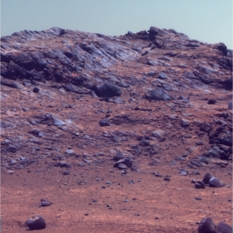
A glimpse of north wall
Opportunity took this image, which shows part of Marathon Valley's north wall, with her Pancam on sol 4108 (Aug. 14, 2015). The Pancam team processed it in false color, a technique that enables scientists to better distinguish the layers and various other geological elements.NASA / JPL-Caltech / Cornell / ASU
What the MER scientists knew for sure was that the clay minerals were there, right where Opportunity was, somewhere. They were using a pixel-by-pixel clay mineral map that Arvidson, a co-investigator on CRISM, and his students at WUSTL produced, to determine the waypoints on the rover's walkabout. The smectites seemed to be spread all over Marathon Valley. Most likely, they hypothesized, in the deep red rocks and soils that defined the so-called “red zones.”
Opportunity seemed to be rocking RAM. "We’ve been getting some spectacular images lately and it’s going surprisingly well," Squyres said.
The MER team confronted an anomaly of a different kind in August, though, with Opportunity’s Pancam. "We noticed that a few times over the past hundred sols or so that a late afternoon sequence would time out and not run to completion, without any obvious explanation," said Bell. Nevertheless, the rover was still managing to take and send home spectacular images of her surroundings.
Analysis on the ground showed “no obvious culprit,” said Bell. It also indicated the timeout errors were of no danger to the cameras or to the rover. “We decided to increase the frequency of the returned data telemetry associated with the late afternoon imaging and proceed to run those sequences again to see if we could gather more information on the cause of the timeout. However, and happily, the error hasn't happened since!” he said at year’s end.
As for the robot herself: "Opportunity's performance continues to be excellent," said Nelson. The rover drove out of August and headed another 13-meters (42.6 feet) farther into the central unit of the valley. She stopped at Private Silas Goodrich, as outcrop that features distinctive, deep red swirl patterns, another possible alteration zone.
The veteran robot field geologist continued her walkabout in September and spent much of the month prospecting for clay minerals at rock outcrops that featured deep red elements. From Pvt. Goodrich, the rover and her colleagues pursued their research of the deep red swirls in another outcrop named Private George Gibson.
The aluminum and silicon that the robot field geologist was uncovering was strong evidence of water alteration, perhaps even an ancient environment inviting enough for the emergence of life. But the precise locations of the clay minerals remained, officially anyway, a mystery.
"We suspect that the red zones may be the phyllosilicate [clay minerals] carrier in this region," said Squyres. "The working hypothesis is that the floor of Marathon Valley is laced by a network of fractures. These fractures provide zones of weakness along which fluids can migrate, and then the migration of those fluids produces local alteration, which changes the color, which changes the chemistry, which changes the mineralogy of the rocks,” he explained.
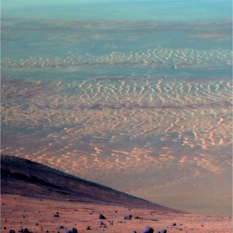
A glimpse inside Endeavour
Opportunity drove into Marathon Valley in July 2015, some six Earth years after the Compact Reconnaissance Imaging Spectrometer for Mars onboard the Mars Reconnaissance Orbiter detected exposures of clay minerals there. Transverse Aeolian Ridges (TARs), which form the ripple field on the floor of Endeavour Crater, are beautifully visible in this false color image processed by the Pancam team. "I think you're going to get used to seeing some pretty spectacular images from this place," said MER Principal Investigator, Steve Squyres.NASA / JPL-Caltech / Cornell / ASU
As Opportunity continued her walkabout, the valley surroundings were looking kind of familiar. "Marathon Valley is looking somewhat like the mountains in the Rockies that have had a lot of water alteration, places where you go prospecting for gems and minerals,” said Arvidson. Prospecting for gems and minerals wasn’t on the rover’s agenda, not yet anyway.
The robot used her flash in September for a total of 10 sols, so the software engineers could “test the functionality and gain some experience with the new flight software,” Nelson said. Opportunity promptly filled the drive with images of the valley’s walls and floor, but then the amnesia and sudden reboot issues she’d been having for more than a year were back.
Opportunity returned to RAM mode on Sol 4155 (October 1, 2015). Feeling the first strains of winter, the robot pressed on, advancing farther into Marathon Valley on her walkabout, heading downhill mapping the valley floor as she went.
In mid-October, the rover almost casually pulled into the southern part of the valley and up onto a north-facing slope. “We kind of just slipped into the winter haven,” said Matt Golombek, MER project scientist, of JPL. “The really good news is that it doesn’t look like we're going to be very constrained this winter.”
Angling her body and solar panels toward the north where the Sun is during fall and winter days, Opportunity got an immediate boost in power. The team got a boost in confidence that the rover would remain mobile through the winter.
The rover’s first major science assignment was to shoot the traditional winter haven panorama. Getting it in the can however was arduous. "A combination of winter coming, operating in RAM mode, the location of the rover relative to the Sun, and inconsistent data return is making it really difficult to complete this panorama," Arvidson said.
The MER ops team managed to get more uplinks with MRO. Since it passes over Opportunity’s site earlier in the Martian day, the rover doesn’t have to stay awake into the evening hours when Odyssey flies by. But the low-elevation geometry of MRO’s orbit and the valley’s high western wall resulted in little, sometimes no data return on several occasions. That left the panorama unfinished and the scientists wanting.
Opportunity didn’t blink. She kept working, looking at the variety of materials right in front and around her, conducting in-depth examinations of a “dirty,” deep red outcrop named Private John Shields; the soil around it, named Private John Thompson; and a “blue” cobble named Private Peter Weiser. "We have detective work to do in Marathon Valley for many months ahead," said Arvidson.
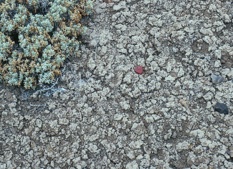
Smectite on Earth
Opportunity is on the hunt in Marathon Valley for the remnant minerals left from clays known as smectites that form in alkaline water. This picture is a close up image of the crinkly, cracked surface typical of smectites found on Earth. Unfortunately, the remnants of the smectite clay minerals in Marathon Valley have not been this obvious, but the MER team knows that they're there and the hunt continues.University of Pittsburgh / Norris W. Jones
Throughout October, the MER software engineers continued their process of “reading out” flash bank 7 to see if there was anything in there other than the code that showed it had been erased and masked. By month's end, they had completed 62.5% of the process. There were no surprises, no clues.
When November set in, many of the MER scientists were jetting off to the Geological Society of America meeting in Baltimore. The rover was busy off-loading or trying to off-load the Marathon Valley images she had stored in flash in September, while the team’s software engineers were trying to evaluate the drive in real time to try and establish its potential usability going forward.
Opportunity succeeded in sending home some of the Pancam images, but after two weeks of effort, there were still “data products” stored in her long-term memory. The robot suffered two sudden reboots during the first two weeks of November. But it was the number of amnesia events that stymied the plan. The team was adamant: it was not ready to give up on flash. It was just time for Opportunity to move on to her winter haven.
"We want to get the rest of the science data down and we want more time in flash, but we've put it off because we're going into winter and lower power and temperatures," said Callas. “We don’t want to do anything that could add any risk to the rover,” he said.
Back in RAM mode, Opportunity finished her investigation on Private Ebenezer Tuttle, and then hiked a little further up the southern wall. When the drive was over, she was angled at about 20 degrees toward the Sun, and sitting in an expanse of layered and fractured outcrops, some rich with deep red banding. “This is a geological treasure trove,” Arvidson said. The MER team named the site Private Isaac White.
As excited as the scientists were about the new digs, the engineers were excited by the tilt. "The energy jumped by 40 watt-hours, from the 340's to 381 watt-hours,” said Jennifer Herman, MER's power team lead. It was better than previous winter projections and something that pretty well confirmed the team’s plan for the rover to work through winter, into spring, and beyond.
Better still, the outcrops on the southern wall seemed to promise answers. Where the “red rocks” on the valley floor were “crumbly” and contaminated with dirt that could have blown in from miles away, these outcrops are more intact and so well exposed. “This is the ‘gold mine,’ so to speak, that will help us understand what’s carrying the clay minerals,” Arvidson said.
With the detailed mineral map based on CRISM data, the clay mineral mystery was coming into focus. "We have found with certainty now the areas that show the phyllosilicate signatures in the orbital data are the same areas that are characterized by the weird red materials that we see here,” Squyres said in November. “There is a one-to-one correlation between where the red zones are and the phyllosilicate signatures are.”
Red zones appear as “swirls in outcrops on the floor, in linear veins, and maybe even as layers in strata,” Arvidson said.

NASA / JPL-Caltech / Cornell / ASU
Hinner's Point
Opportunity used her Pancam to capture this view of part of Marathon Valley's northern wall, which the team named Hinners Point in September 2015. Noel Hinners, a beloved space exploration leader, passed away Sep. 5th. "It was very important for this team that we find something great to name in his memory and this ridge is one of the most impressive topographic features we've seen in quite some time," said MER PI Steve Squyres. "If you're in Marathon Valley, it's the thing on the skyline." The image, processed in false color by the Pancam team, also shows a portion of the valley floor with the swirling "red zones" where the rover is finding more evidence of water alteration.Opportunity finished out November by taking Pancam images of targets in the Pvt. White “treasure trove.” The robot looked at one outcrop, Private Hugh McNeal, up-close with her MI and later with her APXS to determine its chemical make-up on Sol 4211 (November 28, 2015).
The veteran robot explorer then spent the first week of December there, taking close-up pictures of a chosen spot on Pvt. McNeal, with her MI and Pancam, and then analyzing its chemistry with her APXS. She also brushed a spot and repeated the same close-up investigations.
During the second week of the month, on Sol 4222 (December 9, 2015), Opportunity bumped back about 3.65 meters (about 12 feet) to set up for an approach to a new outcrop target, named Private John Potts. “There are tan rocks and deep red rocks. Pvt. Potts is one of the tan rocks. We want to get the base composition of the tan rocks on both an undisturbed spot and ground rock to see how they differ from the red zone rocks,” explained Arvidson.
The next sol, the robot bumped forward about 70 centimeters (2.29 feet), but the wheel currents exceeded protective set points for this steep terrain and the drive stopped. Opportunity made another attempt the following sol, but again the steep terrain stopped her in her tracks after only 1.1 meters (3.60 feet) of wheel motion. Getting to Pvt. Potts was proving to be something of a slippery slope.
The MER rover planners / drivers noted slips as high as 50 percent, not uncommon for this steep terrain. But a different approach was in order. So, on Sol 4227 (December 14, 2015), Opportunity backed downslope 3 meters (9.84 feet) and then drove 4.4 meters (14.43 feet) closing in on Pvt. Potts from a more lateral direction.
Two sols later, the rover bumped 0.35 meters to get in position over Pvt. Potts. It would be her last rove of 2015. The robot field geologist took a series of pictures with her MI and then analyzed the chemical composition with her APXS on both an undisturbed surface, as well as a brushed section of the rock’s surface.
The veteran MER celebrated the end of 2015 on Sol 4244 (December 31, 2015) using her RAT to grind into Pvt. Potts. It was a shallow, 1-millimeter grind. But nearly 12 years after landing, it was, by any measure, a good grind.
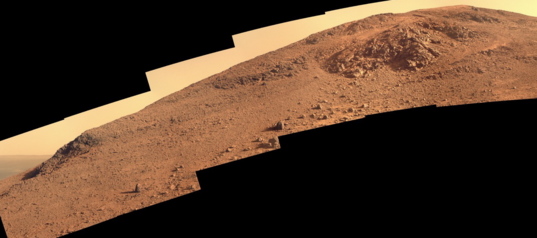
NASA / JPL-Caltech / Cornell / ASU / J. Canvin
Knudsen Ridge
Opportunity used her Pancam to take the pictures that James Canvin, a contributor to The Planetary Society website, processed into this color image of part of Marathon Valley's southern wall. In Dec. 2015, this site, was named Knudsen Ridge, after Danish astrophysicist Jens Martin Knudsen, the scientist behind the magnets on Pathfinder/Sojourner as well as Spirit and Opportunity and other spacecraft. For more on Knudsen: Niels Bohr Inst.Life on Mars was good too. Small but frequent dust cleanings during the final months of the year had provided better fall/winter energy than during the past two Martian winters. More power translated into what was becoming an intriguing winter science campaign in distinctive new sites. And, as December came to an end, Opportunity’s solar array energy was 427 watt-hours and her dust factor was 0.670. The Tau was 0.486. “All very good numbers for winter,” Nelson pointed out.
All through 2015, Opportunity continued to show her MER mettle. Her telemetry, imaging, IDD and mobility systems were – and are – all working very well with no signs of degradation. “And we've been putting them to use,” said Nelson.
As 2016 rang in on Mars, the veteran robot spent a quiet sol. Her agenda however was already packed, drawn well into the future. First, she would check out a peculiar streak of dark material, just to the right of Pvt. Potts, named Private Joseph Collin. Then, she would rove on to her 12th birthday January 24, 2016. From there, she would “slide” west, roving laterally along the Marathon Valley’s southern wall, now Knudsen Ridge, where beautiful deep red rocks and dark rocks are exposed.
“These are the most unusual set of outcrops we’ve ever seen and the first surface examination of the very distinctive smectite detected here by CRISM – and we’re only part way through the detective work,” said Arvidson.
Once winter is over and the work on southern side of the valley is complete, Opportunity may return to the valley floor to study other probable clay-bearing outcrops spotted during the walkabout. Or may be not. The team may opt for heading deeper into Endeavour, deeper into Mars’ past, to look for the contact between the Shoemaker Formation and Matijevic Formation strata among other things.
That plan would take Opportunity down 20 to 25-degree slopes, making it a good mobility experiment, as well as science experiment. Either way, 2016 is already looking to be really interesting. And if the MER team has its way, the rover won’t even think of stopping after that. In fact, plans are already in the works for a mission extension that will take Opportunity and the first overland expedition of Mars through 2018.
Support our core enterprises
Your support powers our mission to explore worlds, find life, and defend Earth. You make all the difference when you make a gift. Give today!
Donate

 Explore Worlds
Explore Worlds Find Life
Find Life Defend Earth
Defend Earth


